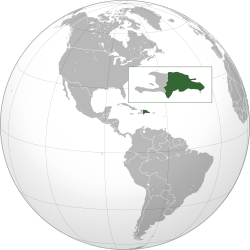Member Nation : Dominican Republic

The Dominican American Association was founded by Maria Perez, Juan Marquez and Lucia Gutierrez in 1993. We formed this organization to promote the cultural and social aspects of our culture. Mainly we celebrate the independence day, el dia de la Altagracia, mothers and fathers day, navidad and the festival of nations. It is a friendly and welcoming group that welcomes anyone of dominican descendance to join us. During the disaster in Haiti we donated money to the victims through the American Red Cross, and the other part to an orphanage in the Dominican Republic, Las Vegas called Hogar Del Padre Fantino. These last couple of years we have been working under the faithful leadership of Maria J. Perez, known as the embassador of the capital region. We are proud to be part of the festival of nations for twenty three years already.
Culture
Palo is an Afro-Dominican sacred music that can be found throughout the island. The drum and human voice are the principal instruments. Palo is played at religious ceremonies—usually coinciding with saints' religious feast days—as well as for secular parties and special occasions. Its roots are in the Congo region of central-west Africa, but it is mixed with European influences in the melodies. Salsa music has had a great deal of popularity in the country. During the late 1960s Dominican musicians like Johnny Pacheco, creator of the Fania All Stars, played a significant role in the development and popularization of the genre.
Ethnic Cuisine
One breakfast dish consists of eggs and mangú (mashed, boiled plantain). Heartier versions of mangú are accompanied by deep-fried meat (Dominican salami, typically), cheese, or both. Lunch, generally the largest and most important meal of the day, usually consists of rice, meat, beans, and salad. "La Bandera" (literally "The Flag") is the most popular lunch dish; it consists of meat and red beans on white rice. Sancocho is a stew often made with seven varieties of meat. Tostones, a fried plantain dish Meals tend to favor meats and starches over dairy products and vegetables. Many dishes are made with sofrito, which is a mix of local herbs used as a wet rub for meats and sautéed to bring out all of a dish's flavors. Throughout the south-central coast, bulgur, or whole wheat, is a main ingredient in quipes or tipili (bulgur salad). Other favorite Dominican foods include chicharrón, yuca, casabe, pastelitos (empanadas), batata, yam, pasteles en hoja, chimichurris, and tostones. Some treats Dominicans enjoy are arroz con leche (or arroz con dulce), bizcocho dominicano (lit. Dominican cake), habichuelas con dulce, flan, frío frío (snow cones), dulce de leche, and caña (sugarcane). The beverages Dominicans enjoy are Morir Soñando, rum, beer, Mama Juana, batida (smoothie), jugos naturales (freshly squeezed fruit juices), mabí, coffee, and chaca (also called maiz caqueao/casqueado, maiz con dulce and maiz con leche), the last item being found only in the southern provinces of the country such as San Juan.
Ethnic Clothing
Tourist Attractions
The Dominican Republic is the most visited destination in the Caribbean. The year-round golf courses are major attractions. A geographically diverse nation, the Dominican Republic is home to both the Caribbean's tallest mountain peak, Pico Duarte, and the Caribbean's largest lake and point of lowest elevation, Lake Enriquillo. The island has an average temperature of 26 °C (78.8 °F) and great climatic and biological diversity. The country is also the site of the first cathedral, castle, monastery, and fortress built in the Americas, located in Santo Domingo's Colonial Zone, a World Heritage Site.
The Dominican Republic is the most popular tourist destination in the Caribbean. With the construction of projects like Cap Cana, San Souci Port in Santo Domingo, Casa De Campo and the Hard Rock Hotel & Casino (ancient Moon Palace Resort) in Punta Cana, the Dominican Republic expects increased tourism activity in the upcoming years.
Ecotourism has also been a topic increasingly important in this nation, with towns like Jarabacoa and neighboring Constanza, and locations like the Pico Duarte, Bahia de las Aguilas, and others becoming more significant in efforts to increase direct benefits from tourism. Most residents from other countries are required to get a tourist card, depending on the country they live in.
Reference Links
Gallery
 |
 |
|---|---|
~2020~ |
Mabel Lorenzo |
~2022~ |
